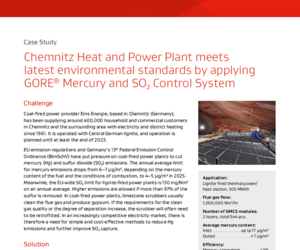Chemnitz Heat and Power Plant meets latest environmental standards by applying GORE® Mercury and SO2 Control System
Case Studies, United States
Coal-fired power provider Eins Energie, based in Chemnitz (Germany), has been supplying around 400,000 household and commercial customers in Chemnitz and the surrounding area with electricity and district heating since 1961. This case study illustrates how Gore helped Eins Energie to reduce mercury emissions to consistently below the applicable limit of 7 μg/m³.
Challenge
EU emission regulations and Germany’s 13th Federal Emission Control Ordinance (BImSchV) have put pressure on coal-fired power plants to cut mercury (Hg) and sulfur dioxide (SO2) emissions. The annual average limit for mercury emissions drops from 6–7 μg/m³, depending on the mercury content of the fuel and the conditions of combustion, to 4–5 μg/m³ in 2025. Meanwhile, the EU-wide SO2 limit for lignite-fired power plants is 130 mg/Nm³ on an annual average. Higher emissions are allowed if more than 97% of the sulfur is removed. In coal-fired power plants, limestone scrubbers usually clean the flue gas and produce gypsum. If the requirements for the clean gas quality or the degree of separation increase, the scrubber will often need to be retrofitted. In an increasingly competitive electricity market, there is therefore a need for simple and cost-effective methods to reduce Hg emissions and further improve SO2 capture.
Solution
In August 2018, W. L. Gore installed two layers of GORE Mercury and SO2 Control Modules (GMCS) with a total of 544 modules in the FGD scrubber at Eins Energie, together with the plant manufacturer Bilfinger Engineering & Technologies (BET) from Würzburg. The installation of the complete system took place during the planned 18-day summer plant shutdown. The initial goal was to significantly reduce Hg emissions to reliably comply with the 13th BImSchV. However, the additional SO2 separation also relieves the FGD scrubber and makes it easier for the company to comply with the total degree of separation and the SO2 limit values without changing the quality of the FGD gypsum. Should the power plant be operated beyond the end of 2023 and should the responsible approval authority then set a lower limit value, or should the Hg content in the lignite increase, Eins Energie can simply expand the flue gas cleaning system by adding a further GMCS module layer.
Results
On average, since installation, the Gore modules have achieved a Hg separation rate of around 43% and sequestered around 100 kg of mercury. Mercury emission levels remain consistently below the applicable limit of 7 μg/m³. Meanwhile, additional SO2 separation has been measured at about 50%. The operating costs of the separation system are very low. In particular, the operational cost of desulfurization is significantly reduced. The only maintenance needed for continuous operation of the system is periodical washing of the modules with water, which is automated for maximum efficiency. The water is then utilized in the formation of gypsum in the absorber. There are no other maintenance costs, nor does the installation require any attention from plant personnel. Because the modules rarely need to be replaced, the investment will pay for itself in a matter of years. In HKW Chemnitz, the total investment amounted to around €5 million. The total costs are in the range of 0.1–0.2 Eurocent per generated kWh.
FOR INDUSTRIAL USE ONLY
Not for use in food, drug, cosmetic or medical device manufacturing, processing, or packaging operations.
